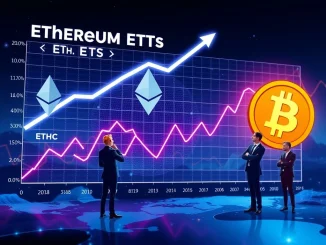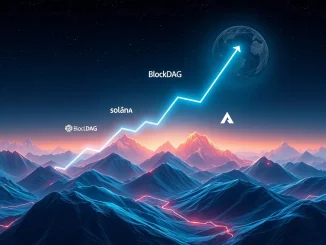
Is the Hyperliquid vault on the brink of a major shift? On-chain analysis is shedding light on the current dynamics within this prominent DeFi platform, revealing a fascinating standoff between major crypto players and potentially jittery smaller investors. Let’s dive deep into what’s happening and what it could mean for you if you’re navigating the volatile world of decentralized finance. This analysis focuses on the Hyperliquid vault situation, crypto whales’ strategies, and the broader DeFi risk landscape, utilizing on-chain analysis to understand the ongoing withdrawals.
Why Are Crypto Whales Still Holding Strong in the Hyperliquid Vault?
According to the astute observations of on-chain analyst @ai_9684xtpa, a significant portion of the Hyperliquid vault – a whopping 15.9%, translating to approximately $36.7 million – is currently controlled by the top 10 depositors. This concentration of wealth in the hands of crypto whales suggests a strong conviction in the platform’s potential, or perhaps a strategic long-term play. But why are these major players unfazed by the subtle shifts in investor sentiment?
Here are a few potential reasons:
- Long-Term Investment Strategy: Whales often operate with a longer time horizon than retail investors. They may be less concerned with short-term fluctuations and more focused on the underlying technology and long-term growth prospects of Hyperliquid.
- Staking and Yield Farming Rewards: Hyperliquid, like many DeFi platforms, likely offers attractive yields for staking or liquidity providing. Whales might be holding onto their deposits to continue earning these rewards, which can significantly outweigh short-term market jitters.
- Confidence in Hyperliquid’s Fundamentals: These top depositors likely conducted thorough due diligence before investing such substantial amounts. Their continued holding suggests a belief in Hyperliquid’s security, technology, and team.
- Market Manipulation or Strategic Positioning: While less palatable, it’s also possible that whales are strategically positioning themselves to influence the market or take advantage of future developments within the Hyperliquid ecosystem.

What Do Small Withdrawals Indicate About DeFi Risk?
While the big crypto whales remain steadfast, the on-chain analysis also reveals the beginnings of small-scale withdrawals from the Hyperliquid vault. These withdrawals, likely initiated by retail investors, could be an early indicator of growing unease or a reaction to broader market conditions. But what exactly do these smaller movements signify in the context of DeFi risk?
Let’s break down the potential implications:
- Fear of Contagion: The crypto market is interconnected, and negative news or price drops in one area can trigger fear and withdrawals across other platforms. Small withdrawals from Hyperliquid might reflect a general risk-off sentiment in the DeFi space.
- Profit Taking: Some retail investors might be simply taking profits after a period of gains in the Hyperliquid vault. This is a normal market behavior and not necessarily a sign of panic.
- Liquidity Concerns (Perceived or Real): Withdrawals, even small ones, can sometimes raise concerns about a platform’s liquidity. If investors perceive a potential liquidity crunch, it can trigger further withdrawals, creating a negative feedback loop.
- Sensitivity to Market Volatility: Retail investors are often more sensitive to market volatility than whales. Minor price fluctuations or negative market signals can prompt them to withdraw their funds as a precautionary measure.
Could Panic Withdrawals Trigger a Negative Feedback Loop in Hyperliquid Vault?
This is the million-dollar question. While the current withdrawals are small, the on-chain analysis highlights a critical concern: panic withdrawals could indeed trigger a negative feedback loop, significantly accelerating liquidation risk within the Hyperliquid vault. How could this scenario unfold?
Imagine a scenario where:
- Increased Withdrawal Pressure: Small withdrawals escalate as more retail investors become concerned, fueled by fear of potential losses or broader market uncertainty.
- Decreasing Liquidity: As more funds are withdrawn, the vault’s liquidity starts to decrease. This can make further withdrawals more challenging and potentially trigger delays or restrictions.
- Price Impact: Large-scale withdrawals could put downward pressure on the price of assets associated with the Hyperliquid vault, especially if these assets need to be sold to meet withdrawal demands.
- Liquidation Cascade: If the value of collateral within the vault decreases significantly due to price drops, it could trigger liquidations, further exacerbating the downward spiral and potentially leading to more panic and withdrawals.
This negative feedback loop is a significant DeFi risk inherent in platforms that rely on leveraged positions and collateralized assets. It’s a scenario that on-chain analysts and investors are closely monitoring.
On-Chain Analysis: Your Window into Hyperliquid Vault Dynamics
The beauty of blockchain technology lies in its transparency. On-chain analysis tools provide invaluable insights into the real-time movements of funds within platforms like Hyperliquid. By tracking wallet addresses, transaction volumes, and deposit/withdrawal patterns, analysts can paint a much clearer picture of market sentiment and potential risks than traditional financial metrics alone. In this case, on-chain analysis has been crucial in identifying the contrasting behaviors of crypto whales and retail investors within the Hyperliquid vault.
Benefits of On-Chain Analysis:
- Transparency: Blockchain transactions are publicly recorded and auditable.
- Real-Time Data: On-chain analysis provides up-to-the-minute information on fund flows.
- Investor Behavior Insights: It can reveal the actions and strategies of different investor segments (e.g., whales vs. retail).
- Risk Assessment: On-chain data can help identify potential risks, such as liquidity crunches or early signs of panic withdrawals.
Navigating DeFi Risk: Actionable Insights for Investors
So, what can you, as a DeFi investor, take away from this situation in the Hyperliquid vault? Understanding DeFi risk and employing informed strategies are crucial for navigating this dynamic space.
Here are some actionable insights:
- Stay Informed with On-Chain Analysis: Utilize on-chain analysis tools and follow reputable analysts like @ai_9684xtpa to stay informed about fund movements and potential risks within DeFi platforms you are invested in.
- Diversify Your DeFi Portfolio: Don’t put all your eggs in one basket. Diversify your investments across different platforms and protocols to mitigate platform-specific risks.
- Understand Vault Mechanics: Thoroughly understand the mechanics of any DeFi vault you invest in, including its liquidation risks, collateralization ratios, and withdrawal procedures.
- Manage Your Risk Tolerance: Only invest what you can afford to lose. DeFi, while offering potentially high rewards, also carries significant risks. Align your investment strategy with your personal risk tolerance.
- Monitor Market Sentiment: Pay attention to broader market sentiment and news that could impact DeFi platforms. Be prepared to adjust your positions if necessary.
Conclusion: Vigilance is Key in the Hyperliquid Vault and Beyond
The situation in the Hyperliquid vault serves as a compelling reminder of the inherent dynamics and potential risks within the DeFi ecosystem. While crypto whales exhibit unwavering confidence, the emergence of small withdrawals highlights the sensitivity of retail investors and the potential for negative feedback loops. On-chain analysis provides a crucial lens for understanding these developments, empowering investors to make more informed decisions. As the DeFi space continues to evolve, vigilance, continuous learning, and proactive risk management will be paramount for navigating its exciting yet challenging landscape. Keep a close eye on these developments and remember that in the world of crypto, staying informed is your strongest asset.



